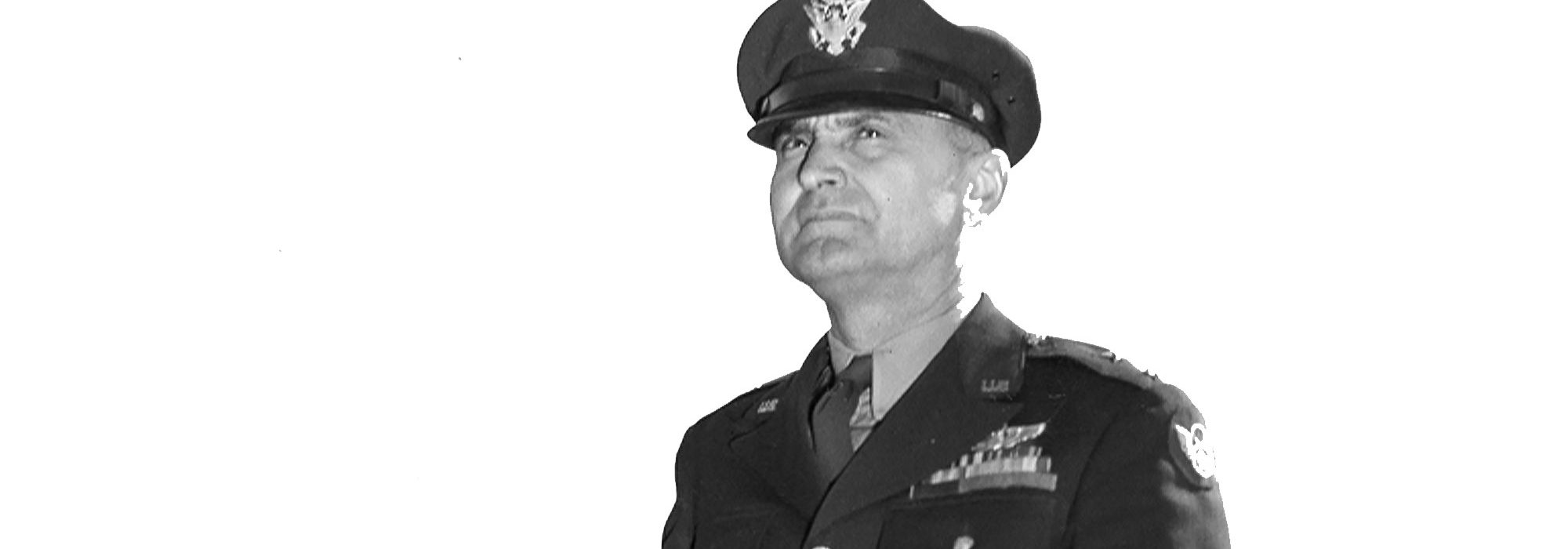Airpower pioneer and commander of the Mighty Eighth.
Ira Eaker joined the Army during World War I as an infantryman, but soon transferred to the Air Service and became a pilot. While at Rockwell Field, Calif., in 1918 he met Henry H. “Hap” Arnold and Carl “Tooey” Spaatz. The three became fast friends and would remain so for the rest of their careers and lives.
Eaker was an outstanding pilot. He led the Pan American Goodwill Flight to South America in 1927, winning the Mackay Trophy, and two years later piloted the record-breaking Question Mark air-refueling flight—Spaatz was also a pilot on that flight. The following year Eaker made the first nonstop transcontinental flight entirely on instruments.
Eaker had a degree in journalism, and he used that expertise to write and promote the cause of airpower. He coauthored three books with Arnold: This Flying Game (Funk & Wagnalls, 1938), Winged Warfare (Harper, 1941), and Army Flyer (Harper, 1942). All three were pitched to a general audience, explaining aircraft and how they would be used in war.
When war broke out, Arnold sent Eaker to England to command the Eighth Air Force. He protested, arguing that he was a fighter pilot, not a bomber pilot. Arnold responded that is precisely why he was giving him the job: He wanted Eaker to instill a fighter pilot spirit in the bomber crews.
It was a difficult challenge. America, typically, had not been prepared for war, and the air arm was in bad shape. The Army was dominated by ground-warfare zealots, and they had refused to purchase modern and powerful aircraft like the B-17. There were a scant two dozen in the service when war broke out, even though it had first flown in 1935. Rather, the Air Corps was forced to buy hundreds of medium bombers like the B-18—which never saw combat.
The buildup of the Eighth was slow and losses were heavy. Prewar doctrine was wrong: The “Flying Fortresses” were not self-defending. Escort fighters were essential, but such aircraft were not available in 1943. Short-range British Spitfires were used and P-38 twin-boomed Lightnings, but this was not good enough, especially for bombing raids deep into Germany.
The RAF had gone through this same dismal process, and its solution was to abandon its decades-long doctrine of daylight precision bombing, and instead resort to area bombing at night. It was safer. RAF leaders urged Eaker to go the same route, but he refused. At the Casablanca Conference in January 1943 he pled his case to British Prime Minister Winston Churchill, arguing that “around the clock bombing” of Germany with Bomber Command operating at night and his Eighth Air Force operating in the day would give the enemy no respite and would eventually bring him and his war industry to its knees. Churchill was convinced.
Even so, it was one thing to accept the concept and quite another to carry it out. In August 1943 the Eighth AF struck the ball-bearing plants in Schweinfurt, Germany. Prewar doctrine had postulated that such a target was a “bottleneck” whose destruction would have a major, cascading effect throughout German industry. The mission was a nightmare—60 aircraft went down, 20 percent of the attacking force. Five such missions and there wouldn’t be an Eighth Air Force.
The savior would be new fighters, the P-47 and P-51, armed with the unglamorous drop tank that allowed escort deep into Germany. The culmination was “Big Week,” when in late February 1944 the backbone of the Luftwaffe was broken. Air superiority was finally achieved, allowing not only an escalating bomber campaign that utterly destroyed German production, but also facilitated the successful landings in Normandy.
By then, however, Eaker was gone. Arnold was never a patient man. Although he deeply respected and trusted his old friend, he decided it was time for a change. Eaker was promoted to lieutenant general and sent to the Mediterranean theater to take command of the Allied Air Forces there. Eaker did not want to go and considered it a “kick upstairs.” He was no doubt correct.
As the war wound down in Europe, Eaker was summoned back to Washington. Arnold had suffered his fourth heart attack and wanted him near to help run the Air Force. The two men discussed the future and decided that an independent Air Force, equipped with atomic bombs, would dominate the postwar military. It was the young generals who would have to get this done. For the pioneers, it was time to retire.
Eaker retired in 1947, but remained a staunch advocate for the new Air Force. In 1985, President Ronald Reagan signed legislation promoting Eaker to full general. He never wrote his memoir, but the three books noted above are an excellent starting point for understanding his thoughts. An excellent biography was written by former subordinate James Parton, “Air Force Spoken Here:” General Ira Eaker and the Command of the Air (Adler & Adler, 1986).
